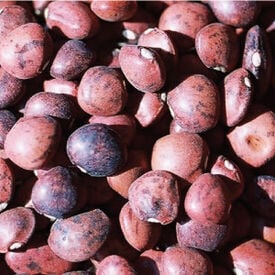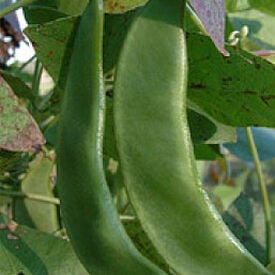The Eastland bean, scientifically known as Phaseolus vulgaris 'Eastland,' is a popular variety of bush bean that hails from the United States. It is highly esteemed for its exceptional taste and ease of cultivation. Eastland beans belong to the family Fabaceae and are a warm-season crop commonly grown in gardens and small-scale farms. In terms of taste, Eastland beans are celebrated for their tender, crisp texture and rich, earthy flavor. They are a delight to eat both raw and cooked. The pods of Eastland beans are of medium size, typically measuring around 4-5 inches in length. The plants themselves are compact and bushy, making them suitable for smaller gardens and spaces. These beans have a relatively short maturity period, typically taking around 70-75 days from planting to harvest. The beans are known for their vibrant green color, making them visually appealing as well. Eastland beans are generally resistant to common bean diseases such as bean mosaic virus and rust. They are known to provide a good yield per acre, often ranging from 800 to 1,200 pounds of beans per acre, depending on growing conditions and care. Proper spacing is crucial for their growth, with plants typically spaced 3-4 inches apart in rows that are about 18-24 inches apart. These beans thrive in well-drained soil with full sun exposure and require regular watering to maintain consistent moisture levels in the soil. Overall, Eastland beans are a favorite among gardeners and farmers for their taste, disease resistance, and relatively quick harvest time.
The Burpee Improved Bush Lime bean plants produce large pods, high yields, and perfectly shaped beans. Burpee Improved beans are both larger and thicker than normal lima beans. The growth is even more vigorous, with heavier foliage. The plants are uniformly upright.
Henderson Lima beans, often referred to as Henderson's Bush Beans, are a renowned heirloom variety with a rich history and notable characteristics. Originating in the early 20th century, these beans were developed by the Henderson Seed Company, a notable seed supplier based in the United States. Henderson beans are appreciated for their compact, bushy growth habit, making them well-suited for smaller gardens or container planting. The plants typically reach about 18 to 24 inches in height, which allows for easy management and harvesting without the need for extensive staking or trellising. The beans are characterized by their smooth, green pods and are known for their tender texture and sweet, mild flavor. The pods are generally harvested when they are young and firm, usually in mid to late summer, to ensure the best taste and quality. Henderson beans are valued for their consistent productivity and disease resistance, which contribute to a reliable harvest. With their appealing flavor, compact growth habit, and dependable performance, Henderson beans remain a popular choice among home gardeners seeking a high-quality, easy-to-grow bean variety.
Christmas bean, scientifically known as Phaseolus vulgaris 'Christmas,' is a delightful and unique variety of green bean that adds a festive touch to holiday meals. This particular bean cultivar has a fascinating history dating back to the early 20th century when it was first developed by dedicated plant breeders. Its name, "Christmas bean," is derived from its vibrant red and green coloration, reminiscent of traditional holiday colors. In terms of taste, Christmas beans are known for their tender and crisp texture, making them a delightful addition to a variety of dishes. Their flavor is mildly sweet with a subtle nuttiness, making them a versatile choice for both cooking and salads. The beans typically mature in about 80 to 90 days, making them a relatively quick-growing option for gardeners. The pod size is medium to large, with an average length of 6-7 inches, perfect for harvesting when they are young and tender. Christmas bean plants need staked and can grow up 10' and higher! They are known for their disease resistance, particularly against common bean diseases such as rust and bean mosaic virus. When properly cared for, Christmas bean plants can yield an abundant harvest, with each plant producing a substantial number of pods. For optimal growth, they require well-drained soil, full sun exposure, and regular watering. Plant spacing should be about 4-6 inches apart in rows, and they thrive in a variety of climates, making them a popular choice for gardeners looking to add a festive touch to their holiday season while enjoying a bountiful harvest of delicious, colorful beans.
Jackson Wonder bush lima beans are a treasured heirloom variety with deep roots in Southern agriculture, particularly celebrated in the early 20th century. Known for their compact, bush-type growth habit, these beans typically reach heights of 18 to 24 inches, making them ideal for small gardens and easy to manage without support. The beans are characterized by their creamy white color, often with subtle greenish hues, and they grow in smooth, straight pods. Renowned for their rich, buttery flavor and creamy texture, Jackson Wonder beans are perfect for soups, stews, and as a delightful side dish. Harvesting typically occurs in mid to late summer when the pods are plump and the beans are fully developed but still tender. These plants are vigorous and produce a high yield, thriving in well-drained soil with ample sunlight, while also exhibiting resilience against common pests and diseases. With their delicious taste and reliable productivity, Jackson Wonder bush lima beans remain a favorite among gardeners and culinary enthusiasts alike.
The Dixie Speckled Butterpea is a very productive and tasty lima bean. Smaller beans are about the size of peas. Speckled of red on a deep purple body. Great for Southern states with hot weather. Delicious when picked young. Great for hot climates. Smaller lima bean.
Fordhook 242 beans are a popular variety of lima beans known for their smooth texture and rich, buttery flavor. These beans are characterized by their large, flat, greenish seeds that mature to a creamy, pale yellow when harvested. The Fordhook 242 variety is prized for its resilience and productivity, thriving in both home gardens and larger agricultural settings. With a growing season of about 70 to 80 days, these beans are often used in a wide range of culinary dishes, from soups and stews to side dishes and casseroles. Their versatility, coupled with their excellent taste, makes them a favorite among gardeners and chefs alike.
King of the Garden beans are a classic heirloom variety cherished for their robust growth and exceptional flavor. Developed in the early 20th century, this variety has a rich history in American gardens, particularly noted for its productivity. King of the Garden lima beans are characterized by their vigorous pole growth habit, often reaching heights of 6 to 8 feet, making them ideal for trellises or fences. The pods are typically long, smooth, and bright green, growing up to 7 inches in length. Known for their rich, buttery flavor and tender texture, these beans are perfect for fresh eating, canning, or freezing. Harvesting is best done in mid-summer to early fall when the pods are still young and firm to ensure optimal taste and quality. The plants are not only prolific but also exhibit good disease resistance, making them a reliable choice for gardeners. With their delightful flavor, impressive yield, and historical significance, King of the Garden beans continue to be a favorite among home gardeners and culinary enthusiasts alike.
The small Woods Prolific Lima Bean is perfect for canning, freezing and as a dry bean! The bean plant produces thick green pods with small creamy white seeds. Each pod contains about 3 to 4 seeds. The Woods Prolific Lima Bean prefers full sun and has early to mid maturity and produces continuously until frost.









